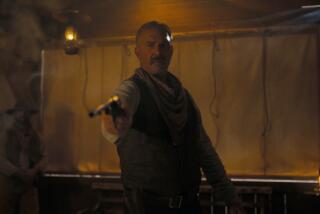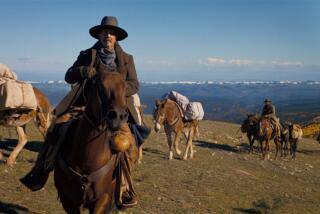Movie Review : A True-to-Life Shot of the O.K. Corral : ‘Wyatt Earp’ Is On Target Historically, but Forces Its Hand Emotionally
- Share via
Impressive but uninviting, “Wyatt Earp” is easier to admire from a distance than pull up a chair and enjoy close-up. A self-conscious attempt at epic filmmaking that feels orchestrated as much as directed, it has noticeable virtues but chooses not to wear them lightly. And at three hours plus, it finally encourages audiences to feel as trail weary and exhausted as any of its characters.
Directed by Lawrence Kasdan (who co-wrote the script with Dan Gordon), “Wyatt Earp” uses the tale of that straight-shooting frontier marshal, the prime mover of the celebrated gunfight at the O.K. Corral, as a way to examine the panorama of the American West from the Civil War years to the turn of the century. And with Kevin Costner in the sturdy title role, Kasdan has the right man to help him do it.
Costner, whose own mammoth “Dances With Wolves” started the most recent trend in elephantine Westerns, is doing what most modern actors avoid, and that is growing and improving within a fairly narrow range. By doing a variation of the kind of innate heroism that characterized John Wayne, he carries “Wyatt Earp” on his shoulders, and if that finally proves too much of a burden, the blame is not his.
Director Kasdan, whose best-remembered films remain his first two, “Body Heat” and “The Big Chill,” has ventured into the West before; his 1985 “Silverado” almost killed the genre’s revival before it began. “Wyatt Earp” is more satisfying, partly because its reported $60-million budget allowed for something like a hundred speaking parts and 92 different sets, including 10 distinctive saloons.
Though it is always diverting to see loving re-creations of everything from the laying of railroad track to the skinning of buffalo, all carefully photographed by Owen Roizman, in some ways this overly schematic pictorialism is evidence of where “Wyatt Earp” goes wrong.
For while it is hard to deny a film its ambition, “Wyatt Earp” is forever trying too hard; its excessive determination to be seen as a classic is too earnest and obvious to be successful. Especially since Kasdan, though clearly a student of the genre in general and the films of John Ford in particular, has to make do without the innate feeling for the iconography and emotional potency of the West that made both “Dances With Wolves” and Clint Eastwood’s “Unforgiven” so successful.
Since that Tombstone, Ariz., gunfight (which historians pinpoint as having really taken place at a less euphonious location at the other end of the block) is what most people associate with Earp, Kasdan opens his picture with a brief pre-corral sequence. It is the morning of the battle and the marshal is drinking coffee in one of those saloons, waiting to be joined by brothers Virgil (Michael Madsen) and Morgan (Linden Ashby) and best friend Doc Holliday (Dennis Quaid).
For the idea of family, the notion, repeatedly articulated by Earp patriarch Nicholas (Gene Hackman) that “nothing counts so much as blood; the rest are just strangers,” is taken totally to heart by the five Earp brothers. They may form romantic liaisons or even marry, but it is the brothers who come first, and Wyatt who is first among equals.
Introduced as an Iowa teen-ager attempting to flee the cornfields and enlist on the Union side in the Civil War, Wyatt is next tracked to a rough frontier town in Wyoming, where the duality of his nature is exposed. As played by Costner, Wyatt in his early 20s is half-boy, half-killer, someone shyly awkward who can turn hard and relentless when he has to.
According to the Gordon-Kasdan script, what tipped the balance in Wyatt’s personality was the outcome of his romance with hometown sweetheart Urilla Sutherland (Annabeth Gish). Post-Urilla, he was different, “a cold man, God forgive you,” as an acquaintance puts it, whose implacable, unbending approach to law enforcement accompanied him and his brothers from Wichita to Dodge City to Tombstone.
To his credit, Costner can convincingly play both sides of the equation, the sheepish, grinning suitor as well as the careworn, emotionally blocked marshal who dresses all in black and barks at miscreants, “I’m Wyatt Earp--it all ends now.” Also worth seeing are Dennis Quaid, who lost 43 pounds to amusingly portray the tubercular gambler Doc Holliday, and Joanna Going, of TV’s “Going to Extremes,” who plays Josie Marcus, a later love of the marshal’s.
That “Wyatt Earp” takes pains to accurately identify Marcus as Jewish, or to cast European-born Isabella Rossellini as Holliday’s Hungarian paramour, Big Nose Kate, is an indication of the film’s interest in historical accuracy. In fact, of the almost numberless pictures made about Earp and Tombstone (of which John Ford’s “My Darling Clementine” remains the best), this is probably the most true to life.
But despite all these things to admire, “Wyatt Earp” offers little to get excited about. Partly it is the film’s habit of pushing too hard, of forcing its emotional moments, and partly it is the glum, morose way Kasdan has envisioned Wyatt’s story as a kind of Greek tragedy with boots on. Though superior to the recent Kurt Russell/Val Kilmer “Tombstone,” it could do with some of that movie’s sense of fun. Not exactly a failure, “Wyatt Earp” is more accurately described as simply not the picture it wants so hard to be.
* MPAA rating: PG-13 for “strong gunfights, some language and sensuality.” Times guidelines: Its gunfights are intense but sporadic.
‘Wyatt Earp’
Kevin Costner: Wyatt Earp
Dennis Quaid: Doc Holliday
Gene Hackman: Nicholas Earp
David Andrews: James Earp
Linden Ashby: Morgan Earp
Jeff Fahey: Ike Clanton
Joanna Going: Josie Marcus
A Tig Productions/Kasdan Pictures production, released by Warner Bros. Director Lawrence Kasdan. Producers Jim Wilson, Kevin Costner, Lawrence Kasdan. Executive producers Jon Slan, Dan Gordon, Charles Okun, Michael Grillo. Screenplay Dan Gordon and Lawrence Kasdan. Cinematographer Owen Roizman. Editor Carol Littleton. Costumes Colleen Atwood. Music James Newton Howard. Production design Ida Random. Art director Gary Wissner. Set decorator Cheryl Carasik. Running time: 3 hours, 9 minutes.
* In general release throughout Southern California.
More to Read
Only good movies
Get the Indie Focus newsletter, Mark Olsen's weekly guide to the world of cinema.
You may occasionally receive promotional content from the Los Angeles Times.











